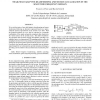Free Online Productivity Tools
i2Speak
i2Symbol
i2OCR
iTex2Img
iWeb2Print
iWeb2Shot
i2Type
iPdf2Split
iPdf2Merge
i2Bopomofo
i2Arabic
i2Style
i2Image
i2PDF
iLatex2Rtf
Sci2ools
ICASSP
2010
IEEE
2010
IEEE
Near-field adaptive beamforming and source localization in the spacetime frequency domain
We revisit the topics of near-field adaptive beamforming and source localization following an alternative approach based on a spatiotemporal spectral representation of the acoustic wave field. With the proposed method, the wave field is expressed as a separable combination of the signal and spatial components that characterize the various sources in the acoustic scene. This allows beamforming operations such as beam steering and sidelobe canceling to be translated into a two-dimensional (2D) sampling problem, where the sampling kernels are derived according to a parametric model representing the 2D spectral pattern generated in the presence of a source. Conversely, the spectral pattern can be estimated from an arbitrary input through the use of parametric spectral estimation techniques, providing a novel solution to the near-field source localization problem.
ICASSP 2010 | Signal Processing | Source Localization | Spatiotemporal Spectral Representation | Spectral Pattern |
| Added | 06 Dec 2010 |
| Updated | 06 Dec 2010 |
| Type | Conference |
| Year | 2010 |
| Where | ICASSP |
| Authors | Francisco Pinto, Martin Vetterli |
Comments (0)

